Education, HIV, and Early Fertility
VerifiedAdded on 2023/06/18
|7
|1490
|222
AI Summary
This study focuses on the issues of early fertility and sexually transmitted infections among teenagers in Kenya's schools. It recommends sex education, prevention interventions, and safe sex practices to minimize these issues.
Contribute Materials
Your contribution can guide someone’s learning journey. Share your
documents today.

Master of Advanced
Studies in Children’s
Rights
Studies in Children’s
Rights
Secure Best Marks with AI Grader
Need help grading? Try our AI Grader for instant feedback on your assignments.
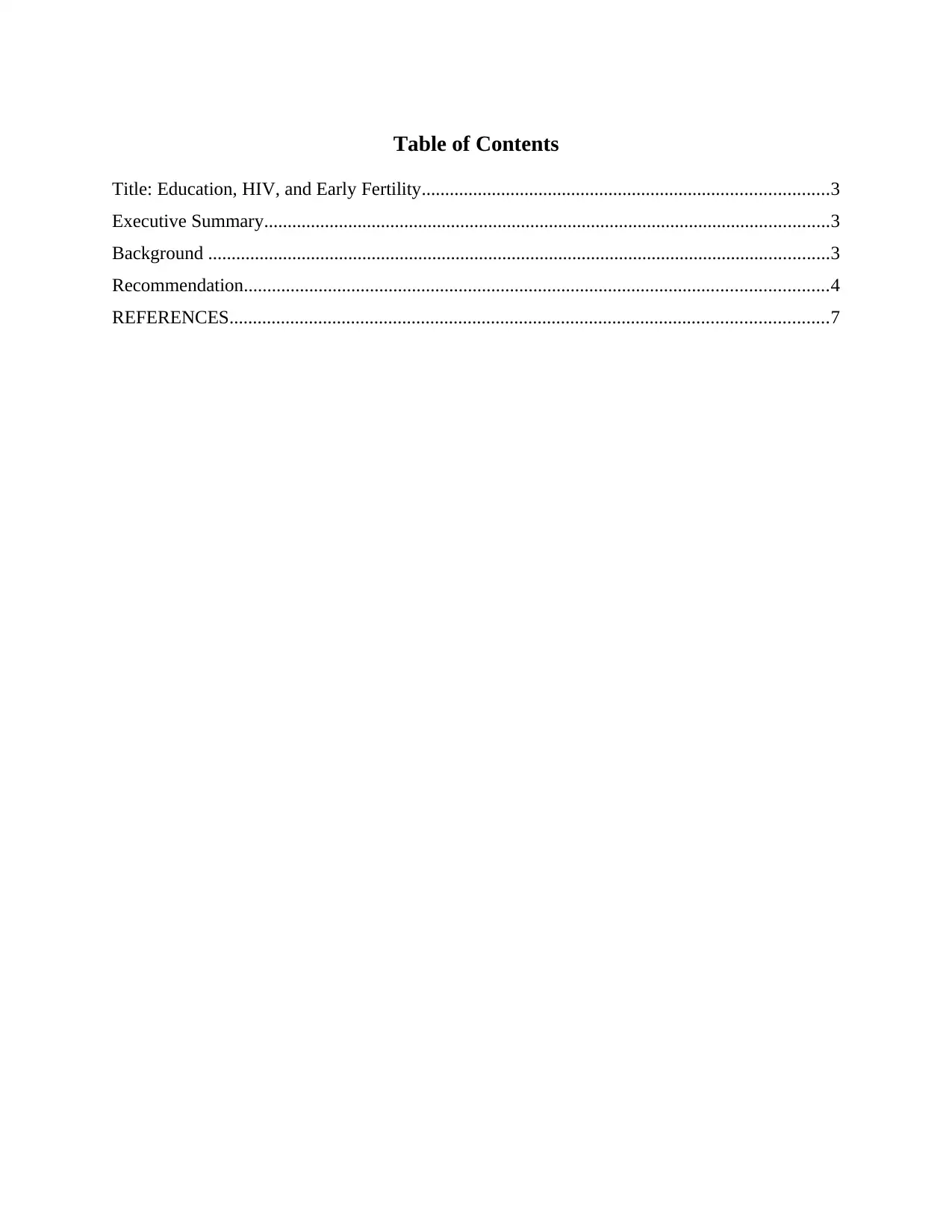
Table of Contents
Title: Education, HIV, and Early Fertility.......................................................................................3
Executive Summary.........................................................................................................................3
Background .....................................................................................................................................3
Recommendation.............................................................................................................................4
REFERENCES................................................................................................................................7
Title: Education, HIV, and Early Fertility.......................................................................................3
Executive Summary.........................................................................................................................3
Background .....................................................................................................................................3
Recommendation.............................................................................................................................4
REFERENCES................................................................................................................................7
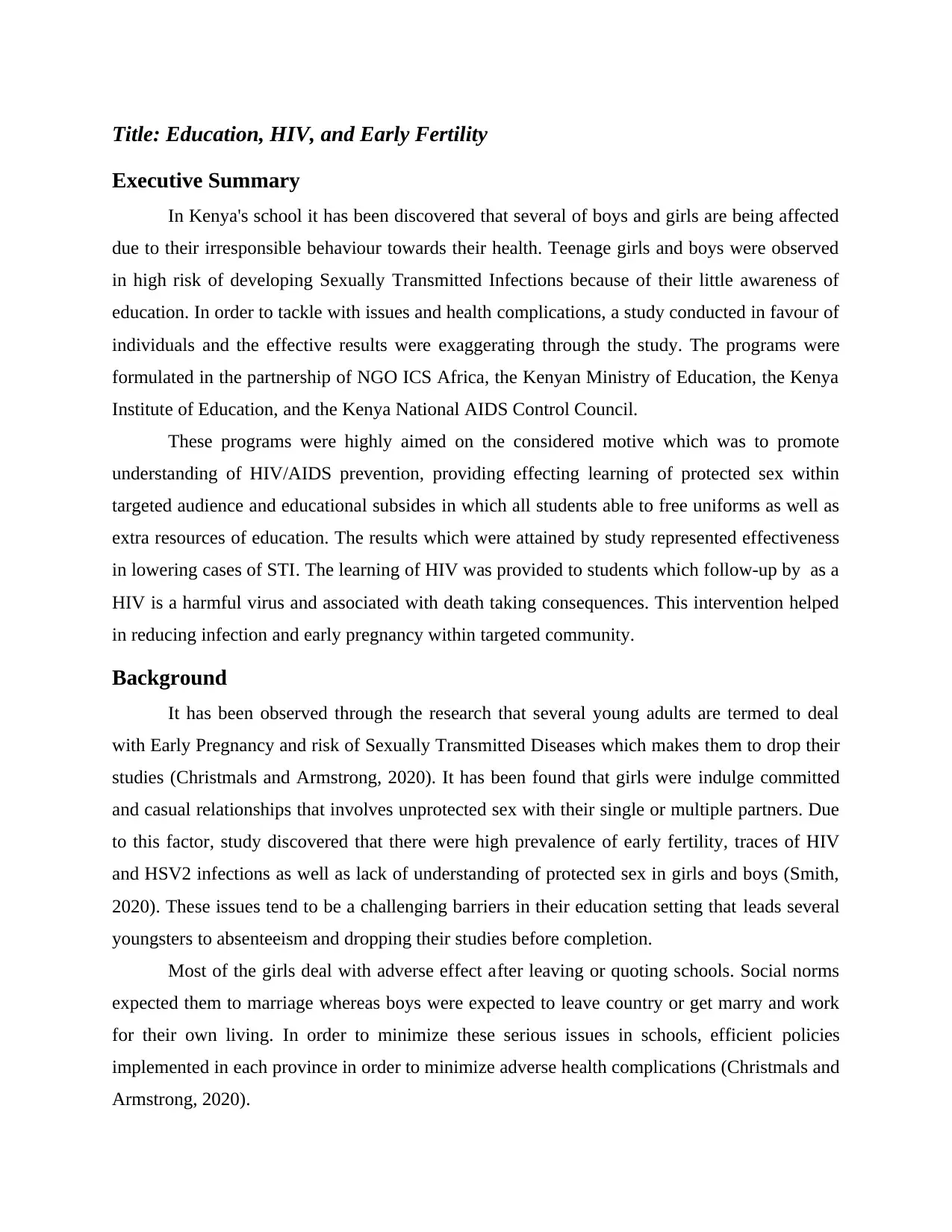
Title: Education, HIV, and Early Fertility
Executive Summary
In Kenya's school it has been discovered that several of boys and girls are being affected
due to their irresponsible behaviour towards their health. Teenage girls and boys were observed
in high risk of developing Sexually Transmitted Infections because of their little awareness of
education. In order to tackle with issues and health complications, a study conducted in favour of
individuals and the effective results were exaggerating through the study. The programs were
formulated in the partnership of NGO ICS Africa, the Kenyan Ministry of Education, the Kenya
Institute of Education, and the Kenya National AIDS Control Council.
These programs were highly aimed on the considered motive which was to promote
understanding of HIV/AIDS prevention, providing effecting learning of protected sex within
targeted audience and educational subsides in which all students able to free uniforms as well as
extra resources of education. The results which were attained by study represented effectiveness
in lowering cases of STI. The learning of HIV was provided to students which follow-up by as a
HIV is a harmful virus and associated with death taking consequences. This intervention helped
in reducing infection and early pregnancy within targeted community.
Background
It has been observed through the research that several young adults are termed to deal
with Early Pregnancy and risk of Sexually Transmitted Diseases which makes them to drop their
studies (Christmals and Armstrong, 2020). It has been found that girls were indulge committed
and casual relationships that involves unprotected sex with their single or multiple partners. Due
to this factor, study discovered that there were high prevalence of early fertility, traces of HIV
and HSV2 infections as well as lack of understanding of protected sex in girls and boys (Smith,
2020). These issues tend to be a challenging barriers in their education setting that leads several
youngsters to absenteeism and dropping their studies before completion.
Most of the girls deal with adverse effect after leaving or quoting schools. Social norms
expected them to marriage whereas boys were expected to leave country or get marry and work
for their own living. In order to minimize these serious issues in schools, efficient policies
implemented in each province in order to minimize adverse health complications (Christmals and
Armstrong, 2020).
Executive Summary
In Kenya's school it has been discovered that several of boys and girls are being affected
due to their irresponsible behaviour towards their health. Teenage girls and boys were observed
in high risk of developing Sexually Transmitted Infections because of their little awareness of
education. In order to tackle with issues and health complications, a study conducted in favour of
individuals and the effective results were exaggerating through the study. The programs were
formulated in the partnership of NGO ICS Africa, the Kenyan Ministry of Education, the Kenya
Institute of Education, and the Kenya National AIDS Control Council.
These programs were highly aimed on the considered motive which was to promote
understanding of HIV/AIDS prevention, providing effecting learning of protected sex within
targeted audience and educational subsides in which all students able to free uniforms as well as
extra resources of education. The results which were attained by study represented effectiveness
in lowering cases of STI. The learning of HIV was provided to students which follow-up by as a
HIV is a harmful virus and associated with death taking consequences. This intervention helped
in reducing infection and early pregnancy within targeted community.
Background
It has been observed through the research that several young adults are termed to deal
with Early Pregnancy and risk of Sexually Transmitted Diseases which makes them to drop their
studies (Christmals and Armstrong, 2020). It has been found that girls were indulge committed
and casual relationships that involves unprotected sex with their single or multiple partners. Due
to this factor, study discovered that there were high prevalence of early fertility, traces of HIV
and HSV2 infections as well as lack of understanding of protected sex in girls and boys (Smith,
2020). These issues tend to be a challenging barriers in their education setting that leads several
youngsters to absenteeism and dropping their studies before completion.
Most of the girls deal with adverse effect after leaving or quoting schools. Social norms
expected them to marriage whereas boys were expected to leave country or get marry and work
for their own living. In order to minimize these serious issues in schools, efficient policies
implemented in each province in order to minimize adverse health complications (Christmals and
Armstrong, 2020).
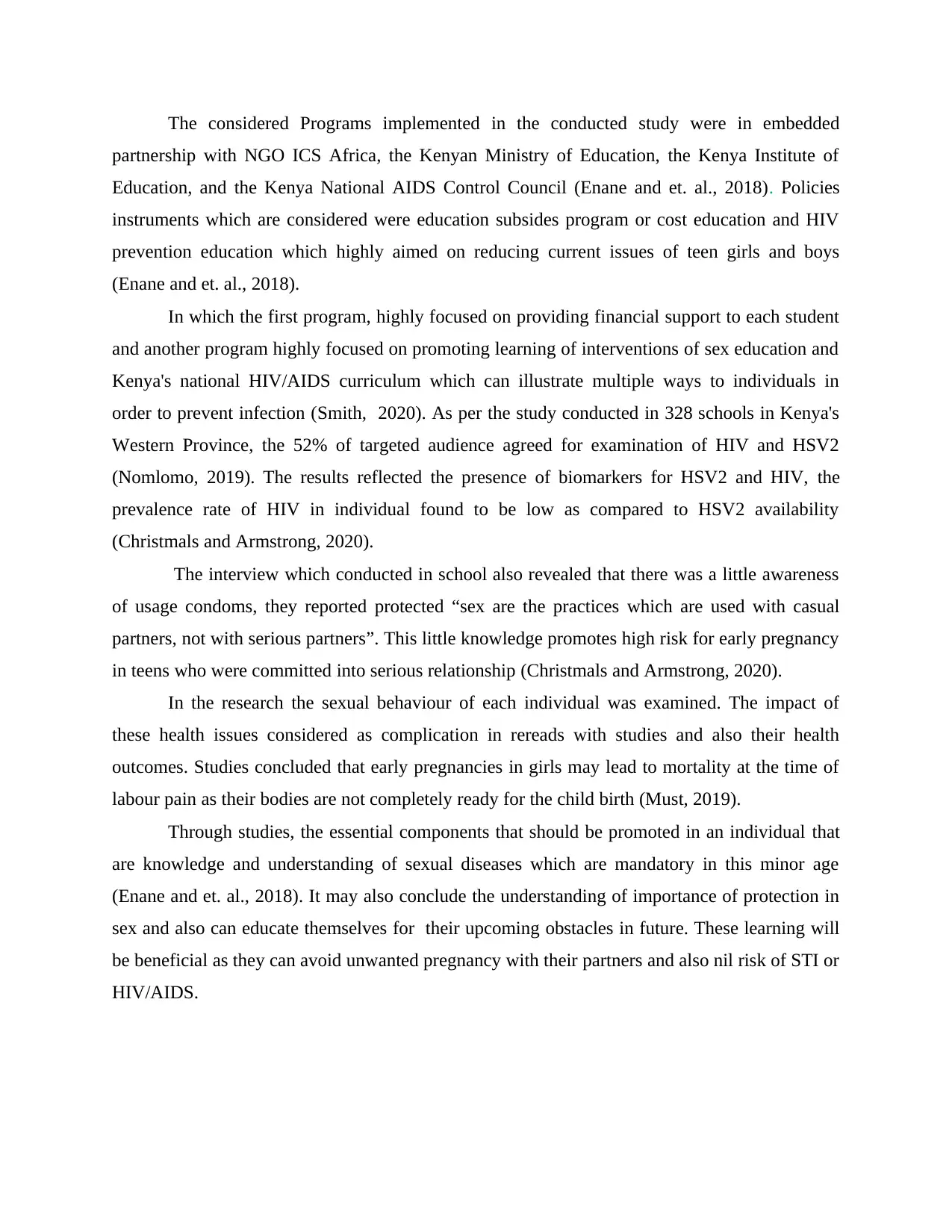
The considered Programs implemented in the conducted study were in embedded
partnership with NGO ICS Africa, the Kenyan Ministry of Education, the Kenya Institute of
Education, and the Kenya National AIDS Control Council (Enane and et. al., 2018). Policies
instruments which are considered were education subsides program or cost education and HIV
prevention education which highly aimed on reducing current issues of teen girls and boys
(Enane and et. al., 2018).
In which the first program, highly focused on providing financial support to each student
and another program highly focused on promoting learning of interventions of sex education and
Kenya's national HIV/AIDS curriculum which can illustrate multiple ways to individuals in
order to prevent infection (Smith, 2020). As per the study conducted in 328 schools in Kenya's
Western Province, the 52% of targeted audience agreed for examination of HIV and HSV2
(Nomlomo, 2019). The results reflected the presence of biomarkers for HSV2 and HIV, the
prevalence rate of HIV in individual found to be low as compared to HSV2 availability
(Christmals and Armstrong, 2020).
The interview which conducted in school also revealed that there was a little awareness
of usage condoms, they reported protected “sex are the practices which are used with casual
partners, not with serious partners”. This little knowledge promotes high risk for early pregnancy
in teens who were committed into serious relationship (Christmals and Armstrong, 2020).
In the research the sexual behaviour of each individual was examined. The impact of
these health issues considered as complication in rereads with studies and also their health
outcomes. Studies concluded that early pregnancies in girls may lead to mortality at the time of
labour pain as their bodies are not completely ready for the child birth (Must, 2019).
Through studies, the essential components that should be promoted in an individual that
are knowledge and understanding of sexual diseases which are mandatory in this minor age
(Enane and et. al., 2018). It may also conclude the understanding of importance of protection in
sex and also can educate themselves for their upcoming obstacles in future. These learning will
be beneficial as they can avoid unwanted pregnancy with their partners and also nil risk of STI or
HIV/AIDS.
partnership with NGO ICS Africa, the Kenyan Ministry of Education, the Kenya Institute of
Education, and the Kenya National AIDS Control Council (Enane and et. al., 2018). Policies
instruments which are considered were education subsides program or cost education and HIV
prevention education which highly aimed on reducing current issues of teen girls and boys
(Enane and et. al., 2018).
In which the first program, highly focused on providing financial support to each student
and another program highly focused on promoting learning of interventions of sex education and
Kenya's national HIV/AIDS curriculum which can illustrate multiple ways to individuals in
order to prevent infection (Smith, 2020). As per the study conducted in 328 schools in Kenya's
Western Province, the 52% of targeted audience agreed for examination of HIV and HSV2
(Nomlomo, 2019). The results reflected the presence of biomarkers for HSV2 and HIV, the
prevalence rate of HIV in individual found to be low as compared to HSV2 availability
(Christmals and Armstrong, 2020).
The interview which conducted in school also revealed that there was a little awareness
of usage condoms, they reported protected “sex are the practices which are used with casual
partners, not with serious partners”. This little knowledge promotes high risk for early pregnancy
in teens who were committed into serious relationship (Christmals and Armstrong, 2020).
In the research the sexual behaviour of each individual was examined. The impact of
these health issues considered as complication in rereads with studies and also their health
outcomes. Studies concluded that early pregnancies in girls may lead to mortality at the time of
labour pain as their bodies are not completely ready for the child birth (Must, 2019).
Through studies, the essential components that should be promoted in an individual that
are knowledge and understanding of sexual diseases which are mandatory in this minor age
(Enane and et. al., 2018). It may also conclude the understanding of importance of protection in
sex and also can educate themselves for their upcoming obstacles in future. These learning will
be beneficial as they can avoid unwanted pregnancy with their partners and also nil risk of STI or
HIV/AIDS.
Secure Best Marks with AI Grader
Need help grading? Try our AI Grader for instant feedback on your assignments.
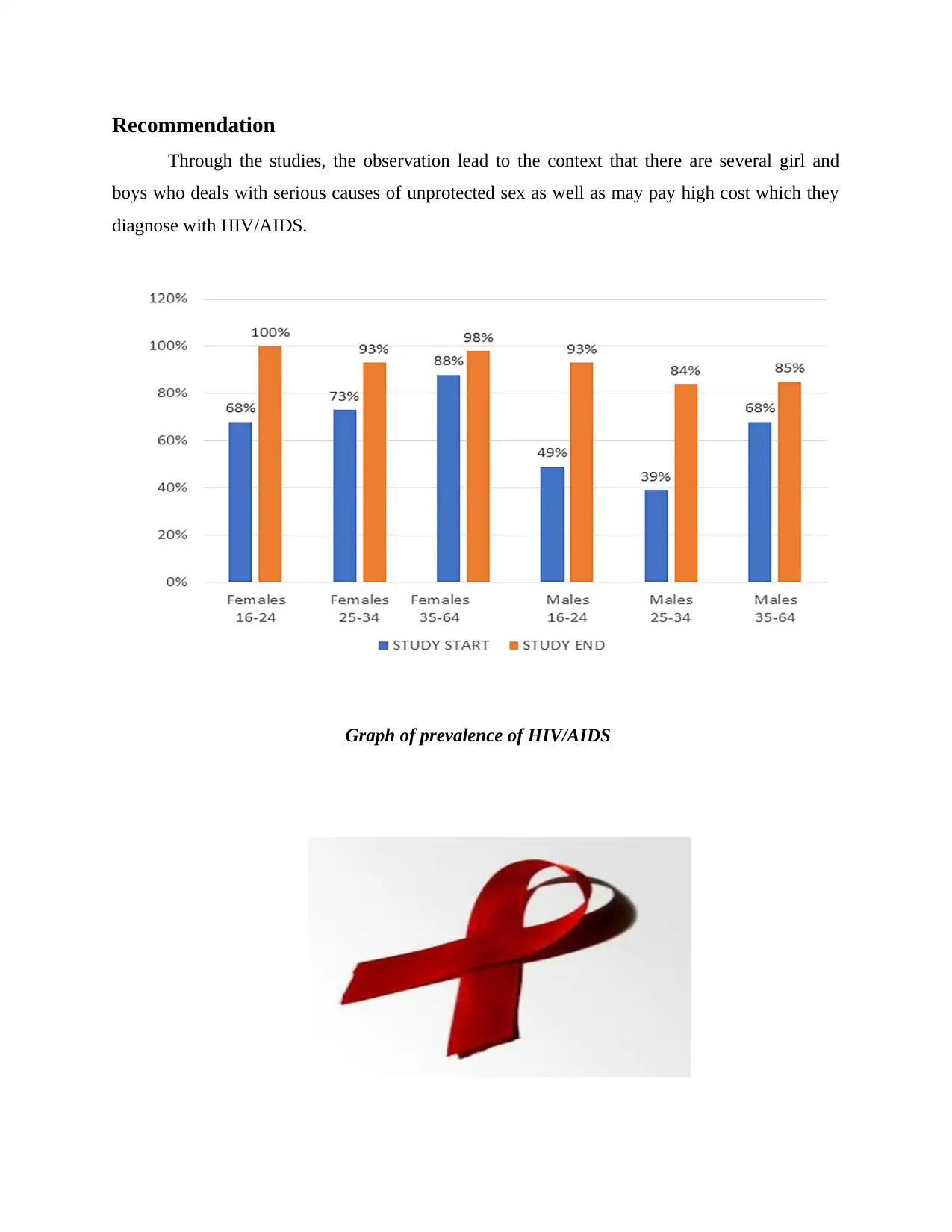
Recommendation
Through the studies, the observation lead to the context that there are several girl and
boys who deals with serious causes of unprotected sex as well as may pay high cost which they
diagnose with HIV/AIDS.
Graph of prevalence of HIV/AIDS
Through the studies, the observation lead to the context that there are several girl and
boys who deals with serious causes of unprotected sex as well as may pay high cost which they
diagnose with HIV/AIDS.
Graph of prevalence of HIV/AIDS
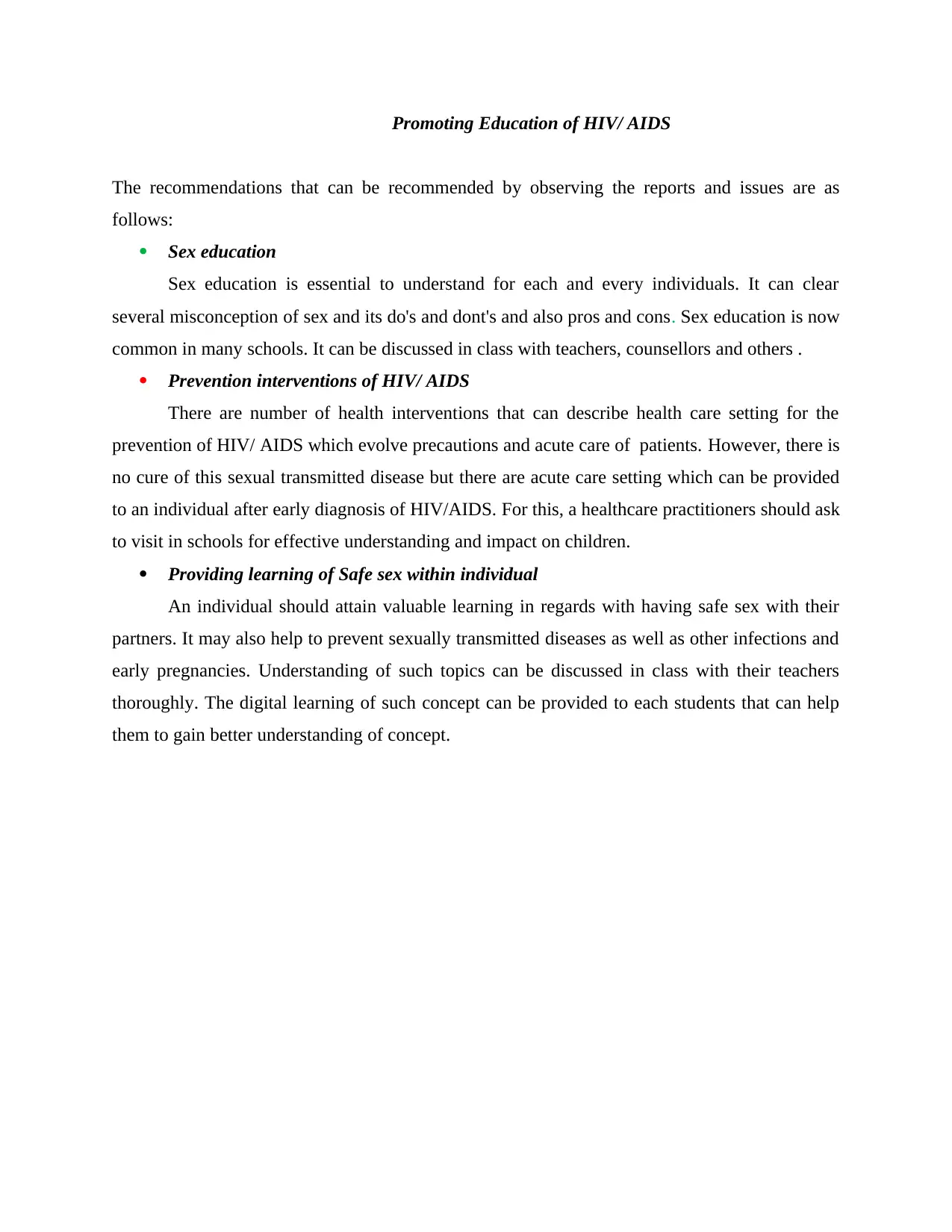
Promoting Education of HIV/ AIDS
The recommendations that can be recommended by observing the reports and issues are as
follows:
Sex education
Sex education is essential to understand for each and every individuals. It can clear
several misconception of sex and its do's and dont's and also pros and cons. Sex education is now
common in many schools. It can be discussed in class with teachers, counsellors and others .
Prevention interventions of HIV/ AIDS
There are number of health interventions that can describe health care setting for the
prevention of HIV/ AIDS which evolve precautions and acute care of patients. However, there is
no cure of this sexual transmitted disease but there are acute care setting which can be provided
to an individual after early diagnosis of HIV/AIDS. For this, a healthcare practitioners should ask
to visit in schools for effective understanding and impact on children.
Providing learning of Safe sex within individual
An individual should attain valuable learning in regards with having safe sex with their
partners. It may also help to prevent sexually transmitted diseases as well as other infections and
early pregnancies. Understanding of such topics can be discussed in class with their teachers
thoroughly. The digital learning of such concept can be provided to each students that can help
them to gain better understanding of concept.
The recommendations that can be recommended by observing the reports and issues are as
follows:
Sex education
Sex education is essential to understand for each and every individuals. It can clear
several misconception of sex and its do's and dont's and also pros and cons. Sex education is now
common in many schools. It can be discussed in class with teachers, counsellors and others .
Prevention interventions of HIV/ AIDS
There are number of health interventions that can describe health care setting for the
prevention of HIV/ AIDS which evolve precautions and acute care of patients. However, there is
no cure of this sexual transmitted disease but there are acute care setting which can be provided
to an individual after early diagnosis of HIV/AIDS. For this, a healthcare practitioners should ask
to visit in schools for effective understanding and impact on children.
Providing learning of Safe sex within individual
An individual should attain valuable learning in regards with having safe sex with their
partners. It may also help to prevent sexually transmitted diseases as well as other infections and
early pregnancies. Understanding of such topics can be discussed in class with their teachers
thoroughly. The digital learning of such concept can be provided to each students that can help
them to gain better understanding of concept.
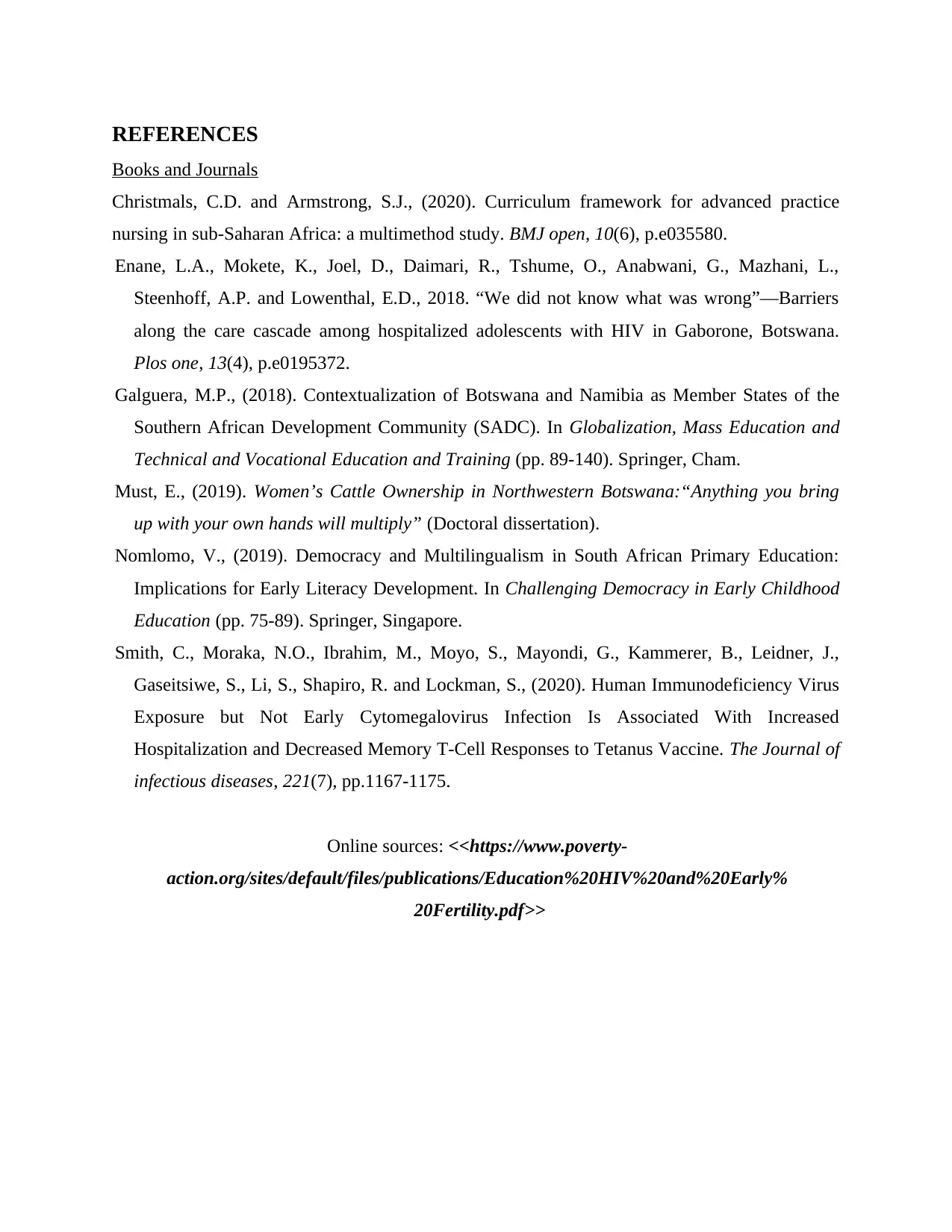
REFERENCES
Books and Journals
Christmals, C.D. and Armstrong, S.J., (2020). Curriculum framework for advanced practice
nursing in sub-Saharan Africa: a multimethod study. BMJ open, 10(6), p.e035580.
Enane, L.A., Mokete, K., Joel, D., Daimari, R., Tshume, O., Anabwani, G., Mazhani, L.,
Steenhoff, A.P. and Lowenthal, E.D., 2018. “We did not know what was wrong”—Barriers
along the care cascade among hospitalized adolescents with HIV in Gaborone, Botswana.
Plos one, 13(4), p.e0195372.
Galguera, M.P., (2018). Contextualization of Botswana and Namibia as Member States of the
Southern African Development Community (SADC). In Globalization, Mass Education and
Technical and Vocational Education and Training (pp. 89-140). Springer, Cham.
Must, E., (2019). Women’s Cattle Ownership in Northwestern Botswana:“Anything you bring
up with your own hands will multiply” (Doctoral dissertation).
Nomlomo, V., (2019). Democracy and Multilingualism in South African Primary Education:
Implications for Early Literacy Development. In Challenging Democracy in Early Childhood
Education (pp. 75-89). Springer, Singapore.
Smith, C., Moraka, N.O., Ibrahim, M., Moyo, S., Mayondi, G., Kammerer, B., Leidner, J.,
Gaseitsiwe, S., Li, S., Shapiro, R. and Lockman, S., (2020). Human Immunodeficiency Virus
Exposure but Not Early Cytomegalovirus Infection Is Associated With Increased
Hospitalization and Decreased Memory T-Cell Responses to Tetanus Vaccine. The Journal of
infectious diseases, 221(7), pp.1167-1175.
Online sources: <<https://www.poverty-
action.org/sites/default/files/publications/Education%20HIV%20and%20Early%
20Fertility.pdf>>
Books and Journals
Christmals, C.D. and Armstrong, S.J., (2020). Curriculum framework for advanced practice
nursing in sub-Saharan Africa: a multimethod study. BMJ open, 10(6), p.e035580.
Enane, L.A., Mokete, K., Joel, D., Daimari, R., Tshume, O., Anabwani, G., Mazhani, L.,
Steenhoff, A.P. and Lowenthal, E.D., 2018. “We did not know what was wrong”—Barriers
along the care cascade among hospitalized adolescents with HIV in Gaborone, Botswana.
Plos one, 13(4), p.e0195372.
Galguera, M.P., (2018). Contextualization of Botswana and Namibia as Member States of the
Southern African Development Community (SADC). In Globalization, Mass Education and
Technical and Vocational Education and Training (pp. 89-140). Springer, Cham.
Must, E., (2019). Women’s Cattle Ownership in Northwestern Botswana:“Anything you bring
up with your own hands will multiply” (Doctoral dissertation).
Nomlomo, V., (2019). Democracy and Multilingualism in South African Primary Education:
Implications for Early Literacy Development. In Challenging Democracy in Early Childhood
Education (pp. 75-89). Springer, Singapore.
Smith, C., Moraka, N.O., Ibrahim, M., Moyo, S., Mayondi, G., Kammerer, B., Leidner, J.,
Gaseitsiwe, S., Li, S., Shapiro, R. and Lockman, S., (2020). Human Immunodeficiency Virus
Exposure but Not Early Cytomegalovirus Infection Is Associated With Increased
Hospitalization and Decreased Memory T-Cell Responses to Tetanus Vaccine. The Journal of
infectious diseases, 221(7), pp.1167-1175.
Online sources: <<https://www.poverty-
action.org/sites/default/files/publications/Education%20HIV%20and%20Early%
20Fertility.pdf>>
1 out of 7
Related Documents
Your All-in-One AI-Powered Toolkit for Academic Success.
+13062052269
info@desklib.com
Available 24*7 on WhatsApp / Email
![[object Object]](/_next/static/media/star-bottom.7253800d.svg)
Unlock your academic potential
© 2024 | Zucol Services PVT LTD | All rights reserved.
